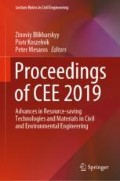Abstract
Theoretical and experimental investigations of the influence of the molecular structure of polyurethane on its vibro- and electroinsulation properties have been carried out. It was established that the rheological model of polyurethane and rubber corresponds to the Kelvin resilient-&-elastic solid. However, due to the lateral electrostatic repulsion between the C = O groups polyurethane has a higher resilient component under compression and subsequent reverse deformation and a higher elastic constituent during the reset after the tension. It conditions the enhanced ability of polyurethane to absorb vibrations in comparison with rubber. Due to the energonegativity, the C = O groups provide a high electrical resistance for the polyurethanes. The experimental data show that polyurethane compositions provide a decrease in the vibration velocity of the rail seat plate in comparison with the track on rubber rail pads and an increase in the electrical resistance between the rail and the plate. The availability of the C = O groups in polyurethane compositions is confirmed by the analysis of the IR-spectra of absorption. When polyurethane is operated under insulation conditions the intensity of C = O lines is decreased with time and it is indicative of the rupture of double bonds, loss of those groups and the degradation of rheological and electric properties.
Access this chapter
Tax calculation will be finalised at checkout
Purchases are for personal use only
References
Anandhan S, Lee HS (2014) Influence of organically modified clay mineral on domain structure and properties of segmented thermoplastic polyurethane elastomer. J Elastomers Plast 46(3):217–232
Lian Z, Huimin L, Zhaofei O (2014) In situ crystal growth of zeolitic imidazolate frameworks (ZIF) on electrospun polyurethane nanofibers. Dalton Trans 43:6684–6688
Lipatov VS, Shilov VV, Gomza YuP, Kruglyak NE (1982) X-ray methods for studying polymer systems. Kyiv, Naukova dumka (in Russian)
Palant O, Plugin D, Plugin A, Lobiak A, Pluhin O (2018) Use of liners made of concrete on quartz aggregates and polyurethane composition to reduce vibration, noise and improve the stability of tramway track. Matec Web of Conf 230:03014
Plugin AN, Palant OV, Plugin DA, Pluhin OA, Borziak OS (2018) Mechanism of protective properties of polyurethane and compositions on the basis of liquid glass against eletric and vibrational effects. Bulletin National Tech Univ “KhPI” Series: Chem Chem Technol Ecol 35(1311):25–28
Plugin AN, Plugin AA, Trikoz LV (2012) Fundamentals of the theory of hardening, strength, destruction and durability of Portland cement, concrete and structures of them. Naukova dumka, Kyiv (in Russian)
Skripinets A, Dachenko Y, Kabus A (2015) A research on technological and physicochemical laws of manufacturing vibration-absorbing products based on epoxy-urethane polymer compositions. Eastern-Eur J Enterp Technol 3(11):4–8
Vuychak I (2009) Modern constructions of a ballast-free canvas as a solution to the operational problems of rail roads. Collected Sci Works Ukrainian State Univ Railway Transp 109:93–113 (in Russian)
Wang H, Liu Y, Tian J, Sun B, Huang S (2013) FT-IR analysis of molecular structure evolvement of poly (Ether urethanes) in Ozone atmosphere. Adv Mater Res 742:215–219
Acknowledgements
The activity presented in the paper is part of the research grant «Theoretical and experimental bases of determining, predicting and ensuring the carrying capacity and durability of transport facilities under aggressive conditions».
Author information
Authors and Affiliations
Corresponding author
Editor information
Editors and Affiliations
Rights and permissions
Copyright information
© 2020 Springer Nature Switzerland AG
About this paper
Cite this paper
Plugin, A.A., Plugin, D.A., Pluhin, O.A., Borziak, O.S. (2020). The Influence of the Molecular Structure of Polyurethane on Vibro– and Electroinsulation Properties of the Tramway Structures. In: Blikharskyy, Z., Koszelnik, P., Mesaros, P. (eds) Proceedings of CEE 2019. CEE 2019. Lecture Notes in Civil Engineering , vol 47. Springer, Cham. https://doi.org/10.1007/978-3-030-27011-7_44
Download citation
DOI: https://doi.org/10.1007/978-3-030-27011-7_44
Published:
Publisher Name: Springer, Cham
Print ISBN: 978-3-030-27010-0
Online ISBN: 978-3-030-27011-7
eBook Packages: EngineeringEngineering (R0)

